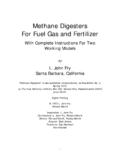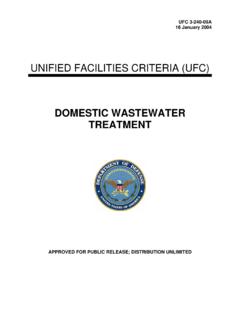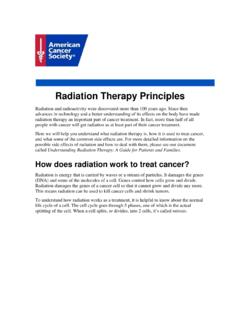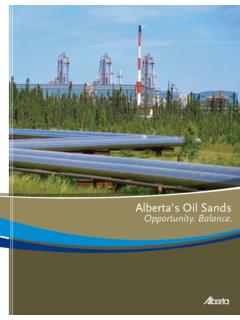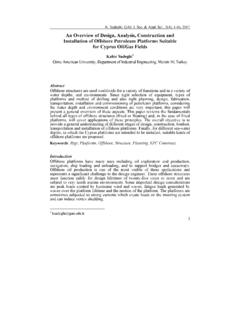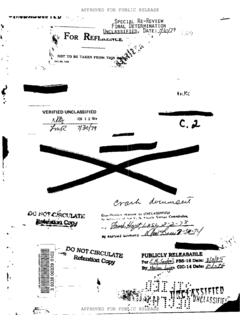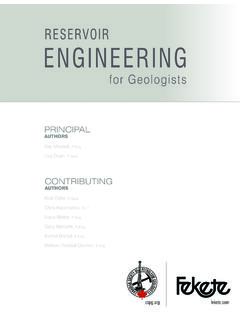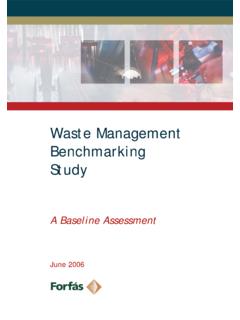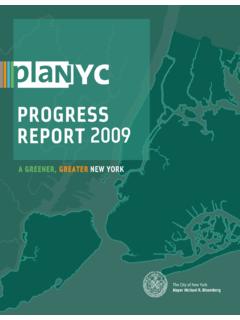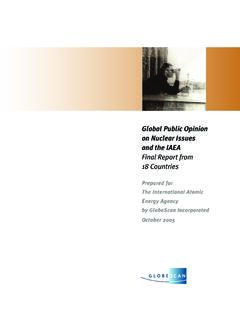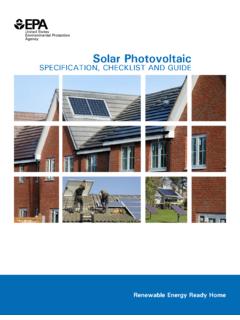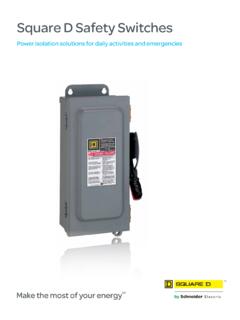Transcription of Space Shuttle Main Engine Orientation - Stanford University
1 Space Transportation SystemTraining DataSpace ShuttleMain EngineOrientationJune 1998 Use this data for training purposes onlyBC98-04 RocketdynePropulsion & PowerBOEING PROPRIETARYBOEING PROPRIETARYBOEING manual is the supporting handout material to a lecture presentation on the Space ShuttleMain Engine called the Abbreviated SSME Orientation Course. This course is a technicallyoriented discussion of the SSME, designed for personnel at any level who support SSME activitiesdirectly or indirectly. This manual is updated and improved as necessary by Betty request copies, or obtain information on classes, call Lori Circle at Rocketdyne (818) 586-2213iBOEING PROPRIETARYBOEING PROPRIETARYBOEING OF CONTENTA cronyms and Propulsion Flow Gas Combustion Oxidizer Fuel Pump Turbine Shaft Pump Turbine Accumulator Pressurizing Suppression System Injector/Combustion Spark System Control Valve Hydraulic Servovalve Actuator Piston Functional PROPRIETARYBOEING PROPRIETARYBOEING OF ILLUSTRATIONSS pace Shuttle Shuttle Shuttle Main Engine Typical Throttling Main Propulsion Component Flex Bellows Tied Flex Joints with Insulating Component Flow Gas Gas Manifold/Injector SSME View Preburner SSME View Preburner SSME View Exchanger Exchanger SSME View Injector SSME View Combustion Chamber.
2 45 MCC Combustion Chamber Oxidizer SSME View Fuel Oxidizer Pump Turbine Seal Fuel Pump Turbine Suppression System Suppression Augmented Spark Control Systems Control Valve Hydraulic PROPRIETARYBOEING PROPRIETARYBOEING OF ILLUSTRATIONSS ervovalve Valve Valve Sequence at Valve Sequence at SSME View SSME View Complete Fluid PROPRIETARYBOEING PROPRIETARYBOEING AND ABBREVIATIONSAFVAnti-Flood ValveASIA ugmented Spark IgniterCCVC hamber Coolant ValveCCVAC hamber Coolant Valve ActuatorCRESC orrosion Resistant SteelDCDirect CurrentDCUD igital Computer UnitEDCuElectrodeposited CopperEDNiElectrodeposited NickelEIUE ngine Interface UnitETExternal TankFASCOSF light Acceleration Safety Cutoff SystemFBVFuel Bleed ValveFPBFuel PreburnerFPLFull Power LevelFPOVFuel Preburner Oxidizer ValveFPOVA Fuel Preburner Oxidizer Valve ActuatorFRIFlow Recirculation InhibitorGCVGOX Control ValveGGGas GeneratorGN2 Gaseous NitrogenGOXG aseous OxygenGPCG eneral Purpose ComputerGSEG round Support EquipmentH2 HydrogenHE(X)
3 Heat ExchangerHEEH ydrogen Embrittlement EnvironmentHGM Hot Gas ManifoldHPFHigh-Pressure FuelHPFTPHigh-Pressure Fuel TurbopumpHPOHigh-Pressure OxidizerHPOTPHigh-Pressure Oxidizer TurbopumpHPVH elium Precharge ValveIEInput ElectronicsLHLeft HandLH2 Liquid HydrogenLO2 Liquid OxygenLOXL iquid OxygenLPFLow-Pressure FuelLPFTPLow-Pressure Fuel TurbopumpLPOLow-Pressure OxidizerLPOTP Low-Pressure Oxidizer TurbopumpLRULine Replaceable UnitLTMCCL arge Throat Main Combustion ChamberLVDTL inear Variable Differential TransformerMAXM aximumMCCMain Combustion ChamberMECMain Engine ControllerMFVMain Fuel ValveMFVAMain Fuel Valve ActuatorMIMain InjectorMOVMain Oxidizer ValveMOVAMain Oxidizer Valve ActuatorMPLM inimum Power LevelMRMixture RatioNCNormally ClosedNONormally OpenedNPLN ormal Power LevelOBVO xidizer Bleed ValveOEOutput ElectronicsOMSO rbital Maneuvering SystemOPBO xidizer PreburnerOPOVO xidizer Preburner Oxidizer ValveOPOVAO xidizer Preburner Oxidizer Valve ActuatorOVOrbiter VehiclePAVP ressure Actuated ValvePEBBPump End Ball BearingPBPreburnerPCAP neumatic Control AssemblyPSIP ounds Per Square InchRCSR eaction Control SystemPHRight HandRIVR ecirculation Isolation ValveRPLR ated Power LevelRPMR evolutions Per MinuteRVDTR otary Variable Differential TransformerSPGGS olid Propellant Gas GeneratorSRBS olid Rocket BoosterSSMES pace Shuttle Main EngineTEBBT urbine End Ball BearingTERBT urbine End Roller BearingVDCV olts direct CurrentWDTW atchdog TimerZRO2 Zirconium OxidevRocketdyne Propulsion & PowerBOEING Shuttle Launch at Kennedy Space Center1 BOEING PROPRIETARYBOEING PROPRIETARYBOEING PROPULSION SYSTEMThe Space Shuttle propulsion system consists of two large solid rocket booster (SRB) motors, three Space Shuttle main engines (SSME),and an external propellant tank (ET), all used to boost the Shuttle orbiter into Space .
4 In addition, the orbiter contains two orbitalmaneuvering system (OMS) engines, and 44 reaction control system (RCS) SRB measures 12 feet in diameter by 149 feet in height, weighs million pounds, and generates approximately million poundsof thrust. The SRBs also serve as launch pad mounts for the entire vehicle and are ignited at launch after all three SSMEs are producingat least 90-percent thrust. The solid propellant consists of a cast mixture of ammonium perchlorate (oxidizer, percent by weight),atomized aluminum powder (fuel, percent), polymer (binder, percent), epoxy (curing agent, percent), and iron oxide(catalyst, percent). After burnout at approximately 150,000 feet, the spent cases separate from the vehicle, arcing up toapproximately 220,000 feet before parachuting to the ocean for recovery and External Tank, at 154 feet long by feet in diameter is the largest element of the Space Shuttle .
5 It serves as the backbonestructure for attachment of the Orbiter and SRBs and also contains and delivers propellants under pressure to the three Orbiter mainengines. The ET must accommodate the stresses created by its own weight, when loaded with propellants, and that of the Orbiter priorto launch. Then at launch the thrust generated by the Orbiter and the SRBs must be reacted by the ET structure. The ET has three majorcomponents: The forward liquid oxygen tank, the aft liquid hydrogen tank, and an unpressurized intertank that joins the two propellanttanks. After the SSMEs are shut down, the ET is jettisoned, enters the Earth s atmosphere, breaks up, and the pieces that survive reentryimpact in a remote ocean area. It is the only element of the Space Shuttle that is not three SSMEs, which are sequentially started at launch, combust a mixture of propellants consisting of hydrogen and oxygen, whichare stored and delivered in a cryogenic liquid state from the external tank (ET).
6 Throttling-down of Engine thrust is necessary early in theascent to prevent excessive aerodynamic loading of vehicle structure and later in the flight to limit vehicle acceleration to no more than 3times normal Earth gravity. Each Engine is gimballed through two planes for vehicle pitch, yaw, and roll control. The SSMEs steer andaccelerate the vehicle to the desired orbital position and velocity, and shut two OMS engines are mounted in pods on either side of the orbiter vertical stabilizer. Each pod also contains Engine propellanttanks and helium tanks used for propellant tank pressurization. The propellants used are monomethylhydrazine (fuel) and nitrogentetroxide (oxidizer), which are hypergolic (ignite on contact). Each Engine produces 6,000 pounds of thrust in a vacuum. They are usedtogether or separately to increase or decrease orbiter velocity for orbit insertion, circularization, transfer, and deorbit.
7 The OMS pods,which are detachable, are serviced in a dedicated facility and reattached to the orbiter during ground turnaround activities. The podsalso contain the aft group of reaction control system reaction control system provides the capability for rotation and translation maneuvers of an orbiter in Space . It includes 38 primarythrusters (870 pounds thrust each), and six vernier thrusters (24 pounds thrust each). The forward thruster group (in the orbiter nose)includes 14 primary and two vernier thrusters. Each OMS pod contains 12 primary and two vernier thrusters. Each thruster can fire apulse as short as 800 milliseconds, using monomethylhydrazine (fuel) and nitrogen tetroxide (oxidizer), which are hypergolic. TypicalRCS uses are: Attitude control as required, roll control during a one-OMS Engine burn, orbiting and deorbiting (if the OMS fails),rendezvous and docking, and station Propulsion & PowerSpace ShuttleOrbiter - 1,805 nmiCross RangePayload CapabilityDiameter= 15 ftLength= 60 ftWeight= 55,000 lbDue East LaunchExternalPropellantTankTwo 146-in.
8 Diameter Solid Rocket Boosters Thrust = lb Each2 Orbital ManeuveringSystem Engines Thrust = 6,000 lb EachCrew ModuleCommanderPilotMission SpecialistPayload SpecialistUp to 6 Passengers3 Space Shuttle Main Engines Thrust = 470,800 lb PROPRIETARYBOEING PROPRIETARYBOEING INTRODUCTIONThe Space Shuttle Main Engine is a staged combustion cycle Engine that burns a mixture of gaseoushydrogen and liquid oxygen. The identifying feature of a staged combustion Engine is that most of thefuel flow (except for a small coolant flow) and a small amount of the oxidizer flow are preburned in apreburner at an extremely fuel-rich mixture. The resulting fuel-rich hot gas is used to power theturbopump turbine, and then injected into the main combustion chamber (MCC) along with the remainingoxidizer and the coolant fuel, all to be final-burned .The SSME is rated at 470,800 pounds thrust (100 percent) in vacuum of 376,600 pounds at sea level.
9 It isthrottleable from 316,100 pounds (67 percent) to 512,900 pounds (109 percent) in approximately 4,700-pound (1-percent) increments. These three thrust levels are called rated power level (RPL), minimumpower level (MPL), and full power level (FPL), respectively. Throttling is accomplished by varying theoutput of the preburners, thus varying the speed of the high-pressure turbopumps and, therefore, thepropellant mass flowrates. The pressure of the burning propellants within the MCC is approximately3,008 pounds per square inch (PSI) at FPL. The MCC propellant mixture ratio is approximately 6 poundsof oxygen to 1 pound of hydrogen, maintained by varying the fuel flowrate around the oxidizer large nozzle with a fairly high expansion ratio of 69 to 1 (nozzle exit area versus throat area) is requiredto fully expand the very high pressure gas in the MCC.
10 Specific impulse in vacuum is 452 seconds ( ,452 pounds of thrust is generated for each pound of propellant burned per second).In order to start, the SSME needs only propellant head for initial propellant flow and spark igniters toinitiate combustion. It has an electronic controller to perform all checkout, start, run, monitoring, andshutdown functions. The Engine is gimballed through two planes by hydraulic actuators for vehiclepitch, yaw, and roll Propulsion & PowerBOEING PROPRIETARYSSME Is the First Reusable LargeLiquid Rocket ft Propellants Rated power level (RPL)100% Nominal power level(NPL) Full power level (FPL)109% Chamber pressure(109%) Specific impulse ataltitude Throttle range (%) Weight Total program hot-firetime Propellants Rated power level (RPL)100% Nominal power level(NPL) Full power level (FPL)109% Chamber pressure(109%) Specific impulse ataltitude Throttle range (%) Weight Total program hot-firetimeOxygen/Hydrogen470,800 lb491,900 lb512,900 lb3,008 psia452 sec67 to 1097,480 lb> 2,660 starts> 832,500 secOxygen/Hydrogen470,800 lb491,900 lb512,900 lb3,008 psia452 sec67 to 1097,480 lb> 2,660 starts> 832,500 sec5 BOEING PROPRIETARYBOEING PROPRIETARYBOEING HIGHLIGHTS Power cycle: Staged combustion.
